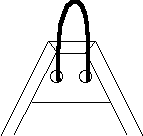

This are the measures for the nylon parts. Not included is the nylon which
you have to add to sew the parts together.
You need eight of the triangle
parts and two of the square ones.

In the edge with the 2cm side of each triangle part you have to put a fitting piece of dacron to strengthen the thing a little bit. You can strengthen the two holes for the rubber band with eyes.

After sewing the four triangles together with the square you get two seperate
parts, formed like a star. At three corners you have to fix a loop of rubber
band.
At the fourth corner you connect the two sides together. The length of
this connection has to be adjusted in the way that the middle of each nylon side
is in the middle of horizontal carbon. The Carbon bars have to be between the
nylon and the line connecting the two nylon sides. This way the nylon is fixed
on the bar.

Put two small rings of tube on the connector. Between these two rings the bridle will be fixed.

For the bridle connected to the horizontal bars you have to knot two of the following loops:

The left side of this loop will be attached to the outer side of the kite, at the two small loops the bridle from the vertical bar and the connector for the line will be attached, the right end with the knot will be attached to a string which connects the two bridles with the bar connector.
To connect the two bridle side together an the whole bridle again to the bar connector use a line with the following measures:
The middle of this line has to be connected in the middle of the bar connector between the rings of tube. At the two ends with the loop the bridles the the two bridlesides have to be attached at the end with the knot.
We also need four strings with the following measures for the bridle part coming from the vertical bar:
Last we need 4 small loops of the size of 4 cm to connect the vertical and the horizontal bridle parts together. At the end with the knot you can attach then the line itself.
The knot we use for all this connection work is the following (use a doubble one to attach the bridle between the two tubes on the bar connector between the two sides):
That's it, folks. Put the whole thing together and enjoy flying your new kit.
I know, this construction plan is not as detailed as it should be, but I
think, if this is not your first kite, it's quite easy to do it.
I'm sure,
there are better ways to construct the bridle, but the way I made it works quite
fine.